cooling TOYOTA RAV4 2010 XA30 / 3.G Owners Manual
[x] Cancel search | Manufacturer: TOYOTA, Model Year: 2010, Model line: RAV4, Model: TOYOTA RAV4 2010 XA30 / 3.GPages: 513, PDF Size: 9.05 MB
Page 345 of 513

344 4-3. Do-it-yourself maintenance
CAUTION
The engine compartment contains many mechanisms and fluids that may
move suddenly, become hot, or become electrically energized. To avoid death
or serious injury, observe the following precautions.
■When working on the engine compartment
●Keep hands, clothing, and tools away from the moving fans and engine
drive belt.
● Be careful not to touch the engine, radiator, exhaust manifold, etc. right
after driving as they may be hot. Oil and other fluids may also be hot.
● Do not leave anything that may burn easily, such as paper or rags, in the
engine compartment.
● Do not smoke, cause sparks or expose an open flame to fuel or the bat-
tery. Fuel and battery fumes are flammable.
● Be extremely cautious when working on the battery. It contains poisonous
and corrosive sulfuric acid.
● Take care because brake fluid can harm your hands or eyes and damage
painted surfaces.
If fluid gets on your hands or in your eyes, flush the affected area with
clean water immediately.
If you still experience discomfort, see a doctor.
■ When working near the electric c ooling fans or radiator grille
Vehicles without smart key system: Be sure the engine switch is OFF. With
the engine switch in the “ON” position, the electric cooling fans may auto-
matically start to run if the air conditioning is on and/or the coolant tempera-
ture is high. ( P. 358)
Vehicles with smart key system: Be sure the “ENGINE START STOP” switch
is OFF. With the “ENGINE START STOP” switch in IGNITION ON mode, the
electric cooling fans may automatically start to run if the air conditioning is on
and/or the coolant temperature is high. ( P. 358)
■ Safety glasses
Wear safety glasses to prevent flying or falling material, fluid spray, etc. from
getting in the eyes.
Page 351 of 513
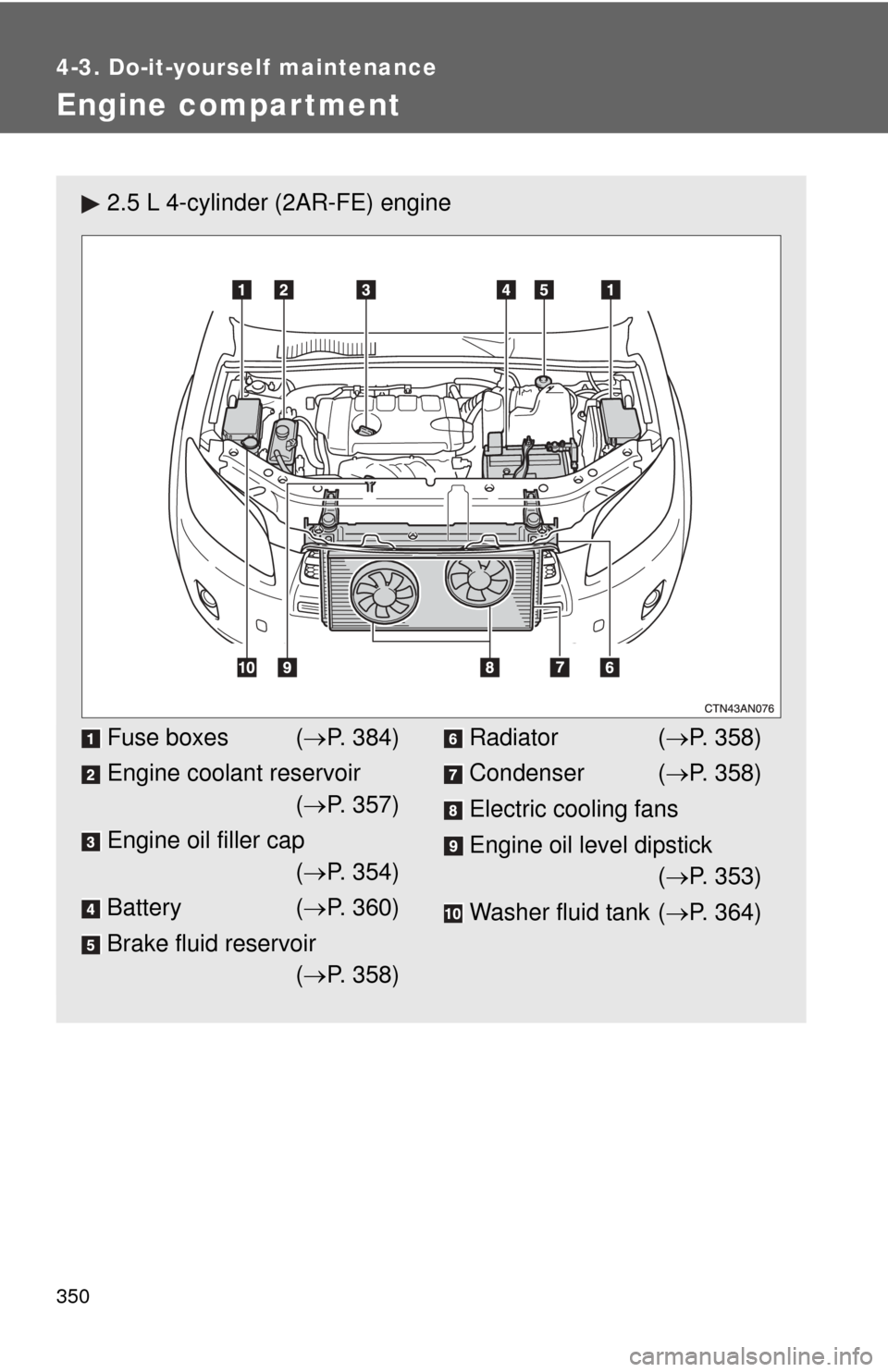
350
4-3. Do-it-yourself maintenance
Engine compar tment
2.5 L 4-cylinder (2AR-FE) engine
Fuse boxes (P. 384)
Engine coolant reservoir ( P. 357)
Engine oil filler cap ( P. 354)
Battery ( P. 360)
Brake fluid reservoir ( P. 358)Radiator ( P. 358)
Condenser ( P. 358)
Electric cooling fans
Engine oil level dipstick ( P. 353)
Washer fluid tank ( P. 364)
Page 352 of 513

351
4-3. Do-it-yourself maintenance
4
Maintenance and care
3.5 L V6 (2GR-FE) engine
Fuse boxes (
P. 384)
Engine coolant reservoir ( P. 357)
Engine oil filler cap ( P. 354)
Battery ( P. 360)
Brake fluid reservoir ( P. 358)Radiator ( P. 358)
Condenser ( P. 358)
Electric cooling fans
Engine oil level dipstick ( P. 353)
Washer fluid tank ( P. 364)
Page 358 of 513
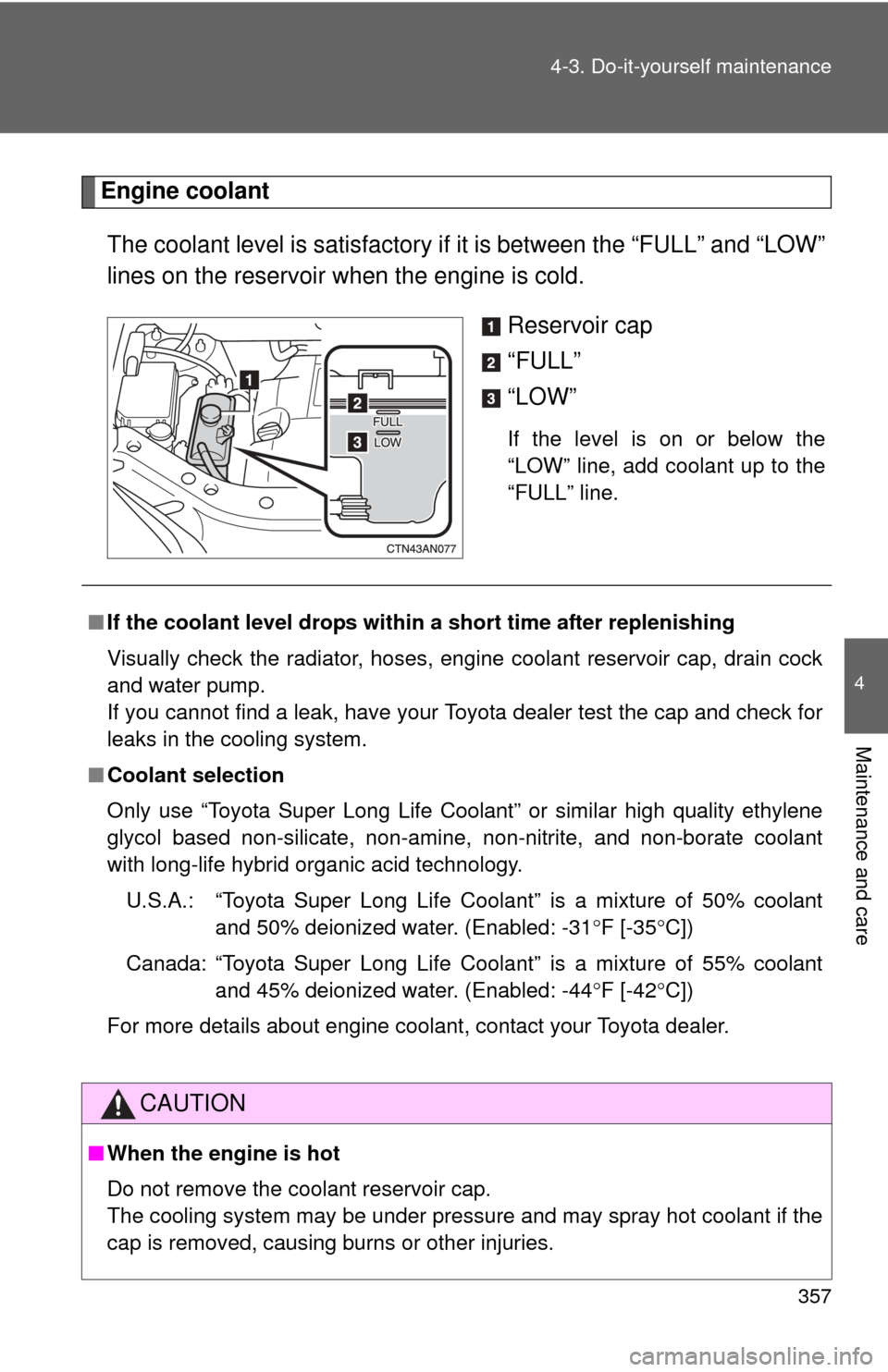
357
4-3. Do-it-yourself maintenance
4
Maintenance and care
Engine coolant
The coolant level is satisfactory if it is between the “FULL” and “LOW”
lines on the reservoir when the engine is cold.
Reservoir cap
“FULL”
“LOW”
If the level is on or below the
“LOW” line, add coolant up to the
“FULL” line.
■If the coolant level drops within a short time after replenishing
Visually check the radiator, hoses, engine coolant reservoir cap, drain cock
and water pump.
If you cannot find a leak, have your Toyota dealer test the cap and check for
leaks in the cooling system.
■ Coolant selection
Only use “Toyota Super Long Life Coolant” or similar high quality ethylene
glycol based non-silicate, non-amine, non-nitrite, and non-borate coolant
with long-life hybrid organic acid technology.
U.S.A.: “Toyota Super Long Life Coolant” is a mixture of 50% coolant and 50% deionized water. (Enabled: -31 F [-35 C])
Canada: “Toyota Super Long Life Coolant” is a mixture of 55% coolant and 45% deionized water. (Enabled: -44 F [-42 C])
For more details about engine coolant, contact your Toyota dealer.
CAUTION
■ When the engine is hot
Do not remove the coolant reservoir cap.
The cooling system may be under pressure and may spray hot coolant if the
cap is removed, causing burns or other injuries.
Page 359 of 513

358 4-3. Do-it-yourself maintenance
Radiator and condenserCheck the radiator and condenser, and clear any foreign objects.
If either of the above parts are ex tremely dirty or you are not sure of
their condition, have your vehicl e checked by your Toyota dealer.
Brake fluid
■ Checking fluid level
The brake fluid level should be
between the “MAX” and “MIN”
lines on the tank.
Make sure to check the fluid type and prepare the necessary items.
NOTICE
■ When adding engine coolant
Coolant is neither plain water nor stra ight antifreeze. The correct mixture of
water and antifreeze must be used to provide proper lubrication, corrosion
protection and cooling. Be sure to read the antifreeze or coolant label.
■ If you spill coolant
Be sure to wash it off with water to prevent damage to parts or paint.
CAUTION
■When the engine is hot
Do not touch the radiator or condenser as they may be hot and may cause
burns.
Page 390 of 513
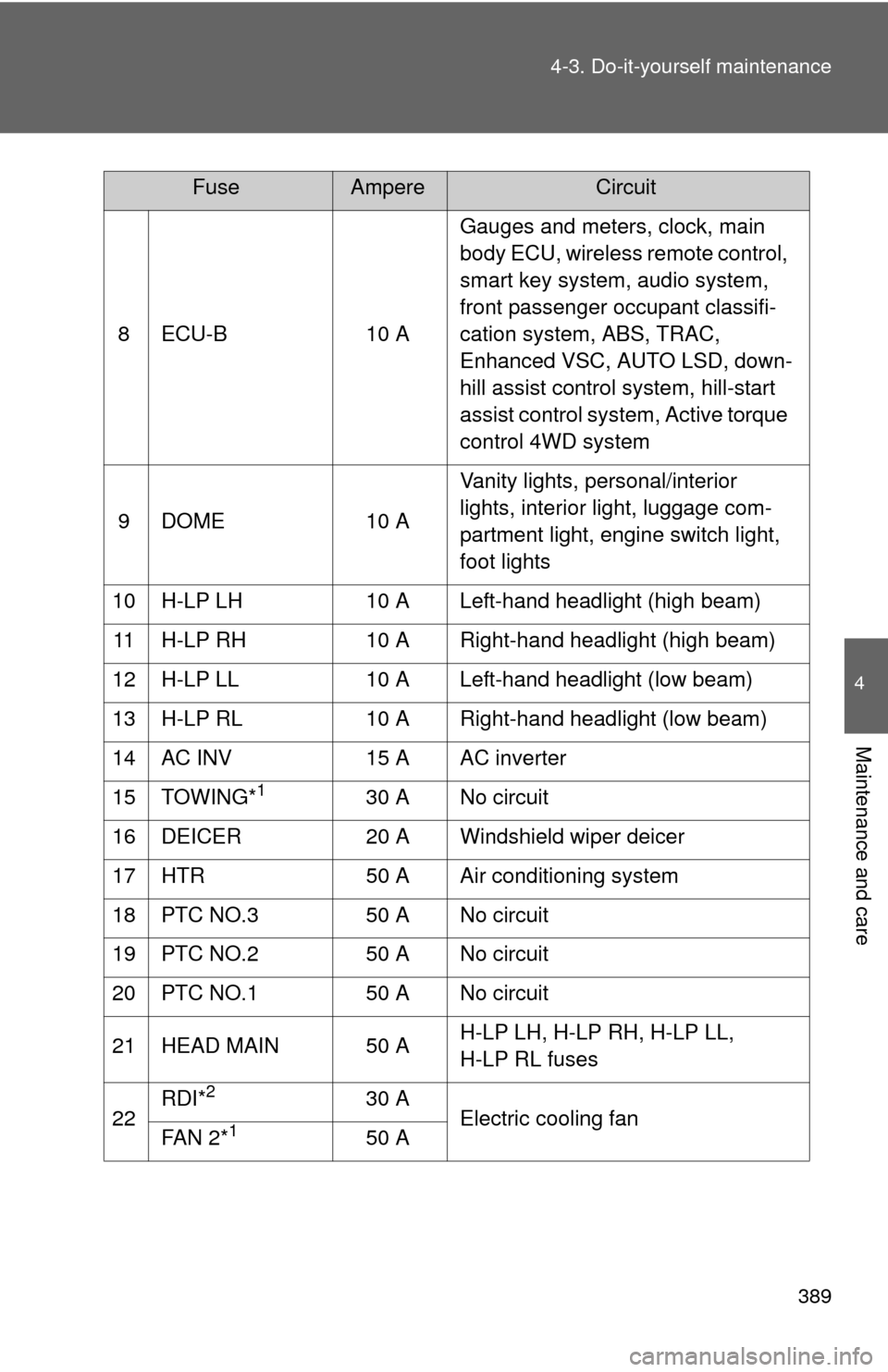
389
4-3. Do-it-yourself maintenance
4
Maintenance and care
8 ECU-B
10 AGauges and meters, clock, main
body ECU, wireless remote control,
smart key system, audio system,
front passenger occupant classifi-
cation system, ABS, TRAC,
Enhanced VSC, AUTO LSD, down-
hill assist control system, hill-start
assist control system, Active torque
control 4WD system
9 DOME 10 AVanity lights, personal/interior
lights, interior light, luggage com-
partment light, engine switch light,
foot lights
10 H-LP LH 10 A Left-hand headlight (high beam)
11 H-LP RH 10 A Right-hand headlight (high beam)
12 H-LP LL 10 A Left-hand headlight (low beam)
13 H-LP RL 10 A Right-hand headlight (low beam)
14 AC INV 15 A AC inverter
15 TOWING*
130 A No circuit
16 DEICER 20 A Windshield wiper deicer
17 HTR 50 A Air conditioning system
18 PTC NO.3 50 A No circuit
19 PTC NO.2 50 A No circuit
20 PTC NO.1 50 A No circuit
21 HEAD MAIN 50 A H-LP LH, H-LP RH, H-LP LL,
H-LP RL fuses
22 RDI*
230 A
Electric cooling fan
FA N 2 *
150 A
FuseAmpereCircuit
Page 391 of 513

390 4-3. Do-it-yourself maintenance
*1: Vehicles with towing package
*
2: Vehicles with 2.5 L 4-cylinder (2AR-FE) engine
*
3: Vehicles with 3.5 L V6 (2GR-FE) engine
Type B (driver’s side)
23 CDS*
230 A
Electric cooling fan
FA N 1 *
350 A
24 H-LP CLN 30 A No circuit
FuseAmpereCircuit
1 AMP 30 A Audio system
2 AM2 30 A Starting system
3 IG2 15 A Starting system, multiport fuel
injection system/sequential multi-
port fuel injection system
4 HAZ 10 A Emergency flashers
5 ETCS 10 A Multiport fuel injection system/
sequential multiport fuel injection
system
FuseAmpereCircuit
Page 394 of 513
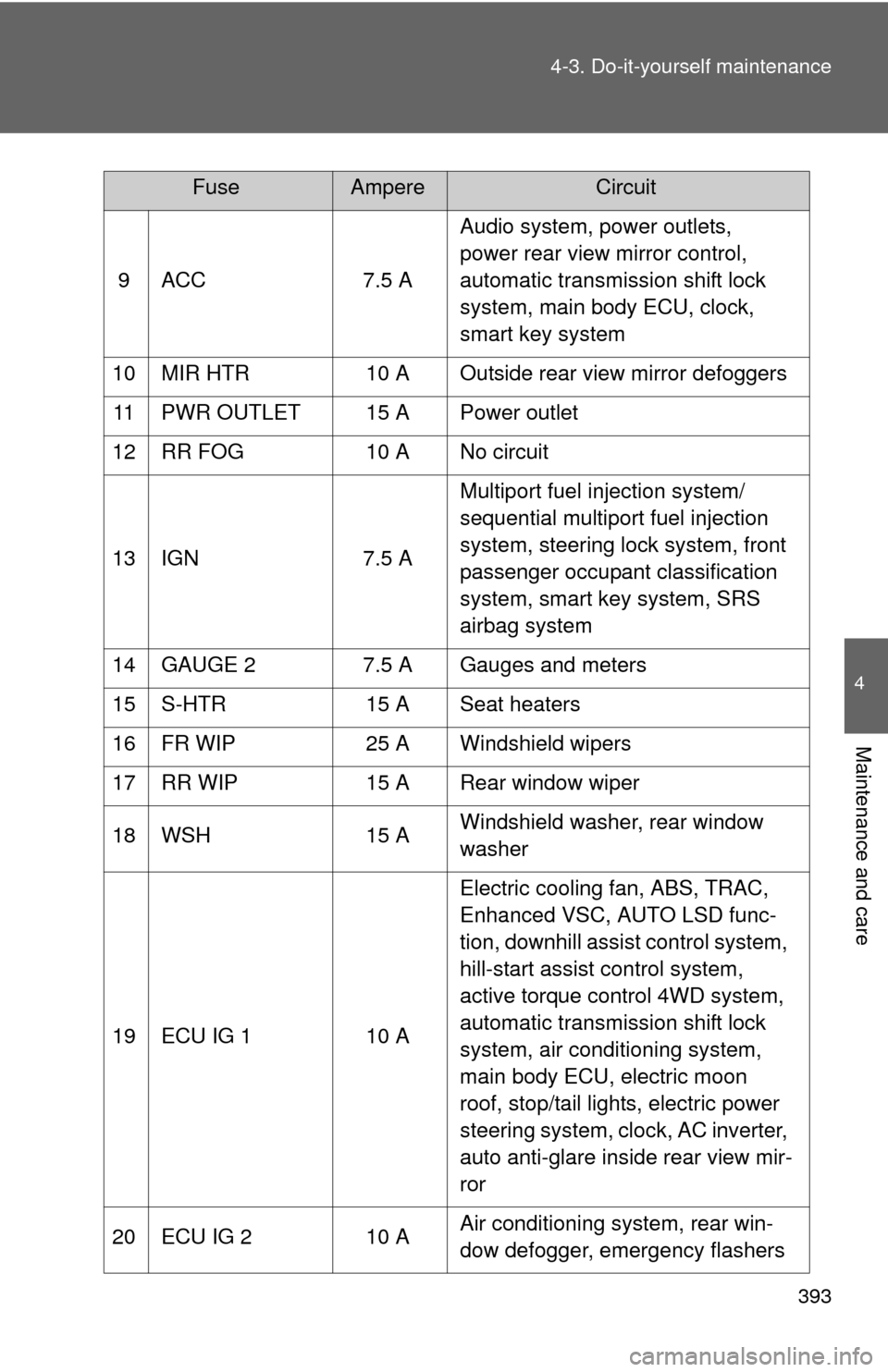
393
4-3. Do-it-yourself maintenance
4
Maintenance and care
9 ACC
7.5 AAudio system, power outlets,
power rear view mirror control,
automatic transmission shift lock
system, main body ECU, clock,
smart key system
10 MIR HTR 10 A Outside rear view mirror defoggers
11 PWR OUTLET 15 A Power outlet
12 RR FOG 10 A No circuit
13 IGN 7.5 AMultiport fuel injection system/
sequential multiport fuel injection
system, steering lock system, front
passenger occupant classification
system, smart key system, SRS
airbag system
14 GAUGE 2 7.5 A Gauges and meters
15 S-HTR 15 A Seat heaters
16 FR WIP 25 A Windshield wipers
17 RR WIP 15 A Rear window wiper
18 WSH 15 AWindshield washer, rear window
washer
19 ECU IG 1 10 AElectric cooling fan, ABS, TRAC,
Enhanced VSC, AUTO LSD func-
tion, downhill assist control system,
hill-start assist control system,
active torque control 4WD system,
automatic transmission shift lock
system, air conditioning system,
main body ECU, electric moon
roof, stop/tail lights, electric power
steering system, clock, AC inverter,
auto anti-glare inside rear view mir-
ror
20 ECU IG 2 10 AAir conditioning system, rear win-
dow defogger, emergency flashers
FuseAmpereCircuit
Page 456 of 513

5
When trouble arises
455
5-2. Steps to take in an emergency
CAUTION
■
Avoiding battery fires or explosions
Observe the following precautions to prevent accidentally igniting the flam-
mable gas that may be emitted from the battery.
●Make sure the jumper cable is connected to the correct terminal and that it
is not unintentionally in contact with any part other than the intended termi-
nal.
● Do not allow the jumper cables to come into contact with the “+” and “-” ter-
minals.
● Do not smoke, use matches, cigarette lighters or allow open flame near
the battery.
■ Battery precautions
The battery contains poisonous and corrosive acidic electrolyte, while
related parts contain lead and lead compounds. Observe the following pre-
cautions when handling the battery.
●When working with the battery, always wear safety glasses and take care
not to allow any battery fluids (acid) to come into contact with skin, clothing
or the vehicle body.
● Do not lean over the battery.
● In the event that battery fluid comes into contact with the skin or eyes,
immediately wash the affected area with water and seek medical attention.
Place a wet sponge or cloth over the affected area until medical attention
can be received.
● Always wash your hands after handling the battery support, terminals, and
other battery-related parts.
● Do not allow children near the battery.
NOTICE
■When handling jumper cables
Be careful that the jumper cables do not become tangled in the cooling fans
or any of the belts when connecting or disconnecting them.
Page 457 of 513
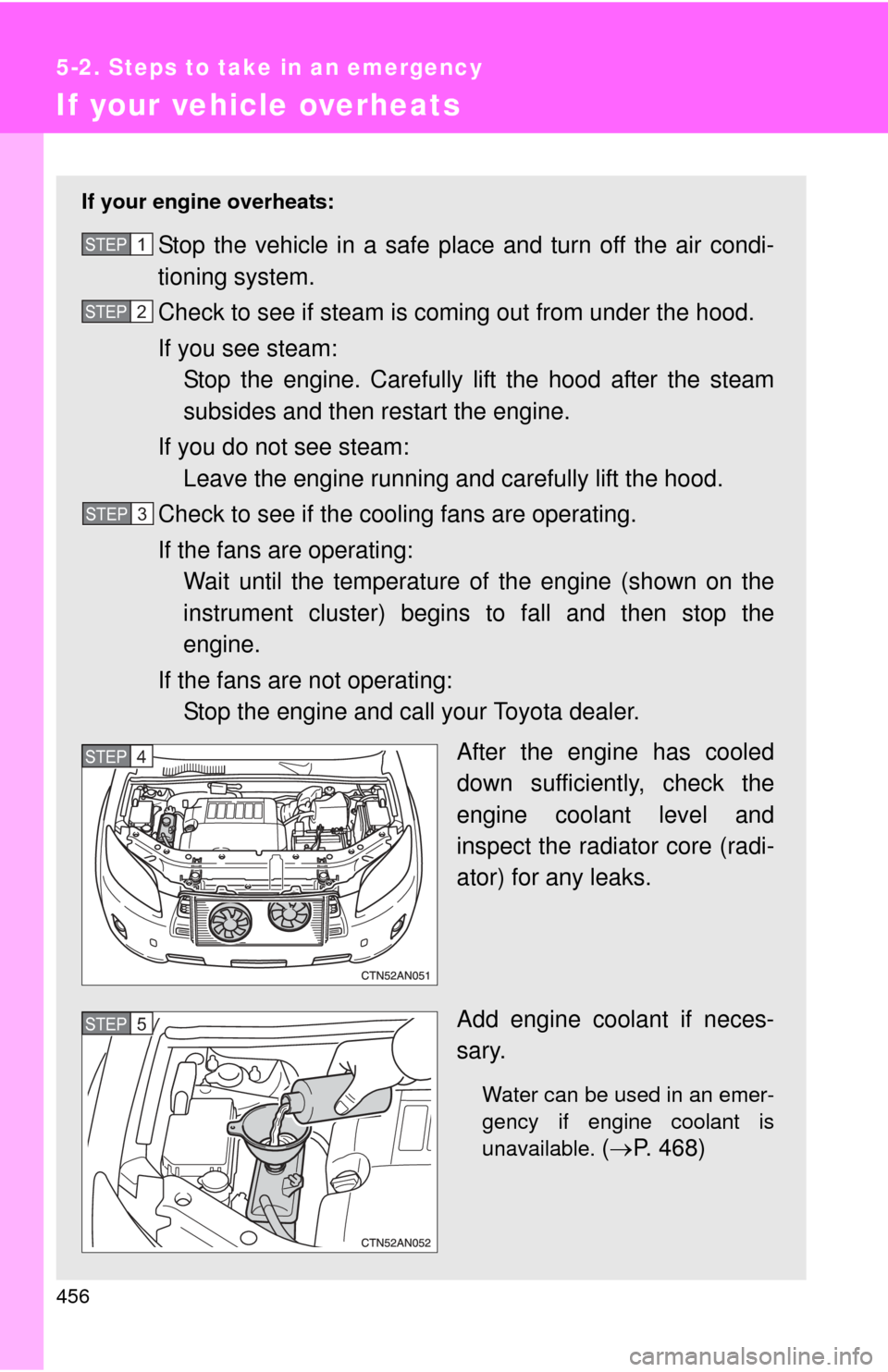
456
5-2. Steps to take in an emergency
If your vehicle overheats
If your engine overheats:
Stop the vehicle in a safe place and turn off the air condi-
tioning system.
Check to see if steam is coming out from under the hood.
If you see steam: Stop the engine. Carefully lift the hood after the steam
subsides and then restart the engine.
If you do not see steam: Leave the engine running and carefully lift the hood.
Check to see if the cooling fans are operating.
If the fans are operating: Wait until the temperature of the engine (shown on the
instrument cluster) begins to fall and then stop the
engine.
If the fans are not operating: Stop the engine and call your Toyota dealer.
After the engine has cooled
down sufficiently, check the
engine coolant level and
inspect the radiator core (radi-
ator) for any leaks.
Add engine coolant if neces-
sary.
Water can be used in an emer-
gency if engine coolant is
unavailable.
( P. 468)
STEP 1
STEP 2
STEP 3
STEP 5 STEP 4
STEP 5